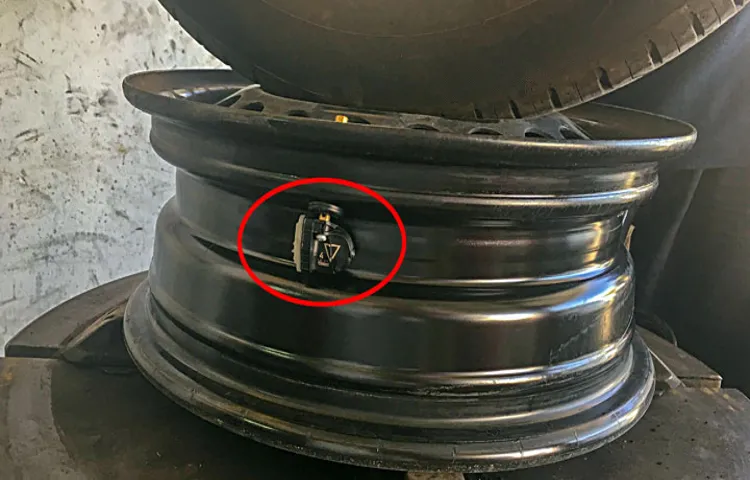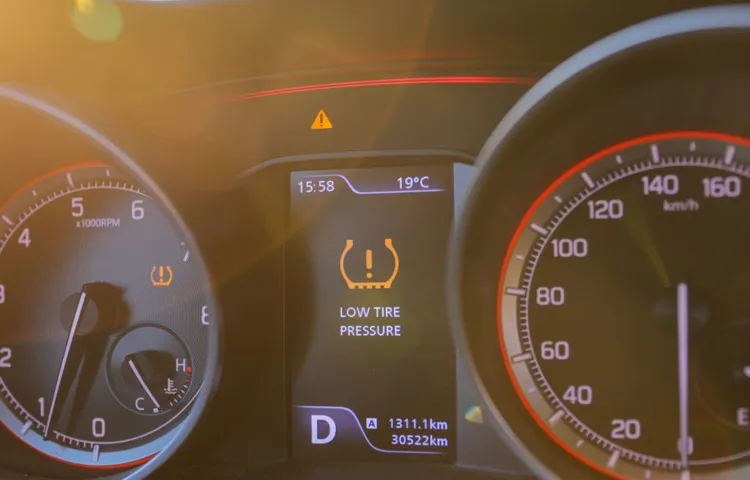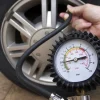Have you ever seen the “Tire Pressure Sensor Fault” warning light illuminate on your dashboard while driving? If you have, you may have wondered what it means or what to do about it. Fortunately, we’re here to help! The tire pressure sensor fault is a warning light that indicates something is wrong with the tire pressure monitoring sensor in your vehicle. This sensor detects the air pressure in your tires and sends the information to the vehicle’s computer, which then displays the data on your dashboard.
So, what causes this warning light to come on? Generally, it can be caused by a faulty sensor, a dead battery in the sensor, or low tire pressure. If left unattended, it can cause damage to your tires, negatively affect your vehicle’s performance, and even lead to an accident. The good news is that there are some easy solutions to fixing a tire pressure sensor fault.
This could include replacing the battery in the sensor, repairing or replacing the sensor itself, or simply inflating the affected tire(s) to the proper pressure level. Keeping an eye on your vehicle’s tire pressure and regularly checking them is essential in preventing this warning light from popping up. Remember, a properly inflated tire leads to better gas mileage, better handling, and an overall safer driving experience.
If you ignore the warning light and continue to drive, you could be putting yourself and your passengers at risk. So, make sure to take the necessary steps to fix the issue and get back on the road safely.
Table of Contents
What is a Tire Pressure Sensor?
A tire pressure sensor or TPMS is a device that monitors the air pressure inside your car tires. It ensures that you’re driving safely and smoothly by providing real-time information about tire pressure. Most modern cars come equipped with tire pressure sensors, which can alert you if your tire pressure is too high or too low.
However, seeing a fault or warning light for your tire pressure sensor can be concerning. It usually means that the system’s sensors, control unit, or wiring is faulty, which can lead to inaccurate readings or no readings at all. It’s important to get this issue resolved as soon as possible since it can impact your driving safety.
If you’re experiencing a tire pressure sensor fault, it’s recommended to take your car to a certified mechanic or dealer for inspection and repair.
Description of Tire Pressure Sensor
A tire pressure sensor, also known as a tire pressure monitoring system (TPMS), is a device that monitors the air pressure in all four tires of a vehicle and alerts the driver if any of them are low. It is a safety feature that helps prevent accidents caused by underinflated tires, which can increase the risk of a blowout or loss of control. The sensor works by transmitting data to a central computer that analyzes the pressure readings and alerts the driver if there is a problem.
It is typically located inside each tire, where it can detect changes in pressure and send the information wirelessly to the computer. This device is becoming increasingly popular in modern vehicles and is now required by law in certain countries. By using a tire pressure sensor, drivers can ensure that their tires are properly inflated, which can improve fuel efficiency, extend tire life, and reduce the risk of accidents on the road.

What Does a Tire Pressure Sensor Fault Mean?
If you notice your vehicle’s tire pressure sensor is indicating a fault, don’t ignore it. Your tire pressure monitoring system works by sending data from sensors inside your tires to a computer system, which alerts you to any deviations from the recommended tire pressure. A sensor fault can indicate a few different issues.
It could mean that the sensor has failed and needs to be replaced, or it could mean that there is a problem with the computer system that reads the sensors. It’s important to get a tire pressure sensor fault checked out promptly, as driving on underinflated tires can lead to decreased fuel efficiency, decreased traction, and even blowouts in extreme cases. Don’t risk it – head to your local mechanic for a checkup if you notice any issues with your tire pressure monitoring system.
Causes of a Tire Pressure Sensor Fault
A tire pressure sensor fault can mean a variety of things, but overall it indicates that there is a problem with the tire monitoring system in your vehicle. This can be caused by a number of factors, including a dead battery in the sensor itself, a damaged or worn out sensor, or an issue with the tire or rim itself. If you notice that your tire pressure warning light is illuminated on your dashboard, it’s important to take action as soon as possible to prevent any potential safety hazards.
One way to address this is to check the tire pressure yourself. But if the issue persists, it may be necessary to take your vehicle to a mechanic. By addressing a tire pressure sensor fault as soon as you notice it, you can help ensure that your vehicle is operating safely and efficiently.
Symptoms of a Tire Pressure Sensor Fault
If you’ve ever had a tire pressure sensor fault, then you know how frustrating it can be. This type of fault means that your vehicle’s tire pressure monitoring system is not working correctly. One of the main symptoms of a tire pressure sensor fault is a warning light on your dashboard.
This warning light is usually in the shape of a tire with an exclamation mark in the middle. Another common symptom is that your tire pressure gauge may read abnormally high or low, even though your tires are properly inflated. This fault can be caused by a variety of factors, including a damaged sensor, low battery, or environmental factors such as extreme temperatures.
If you suspect that you have a tire pressure sensor fault, it’s important to get it fixed as soon as possible, as it can affect the overall performance and safety of your vehicle on the road.
Effects of Driving with a Faulty Tire Pressure Sensor
If your car’s tire pressure sensor is faulty, you may be wondering what this means for the overall performance of your vehicle. Essentially, a faulty tire pressure sensor can cause inaccurate readings, which can lead to a host of issues on the road. For one thing, driving with improperly inflated tires can cause your vehicle to handle poorly and reduce fuel efficiency.
It can also lead to more significant problems like tire blowouts, which can be incredibly dangerous while driving at high speeds. Furthermore, a faulty sensor may prevent your car’s TPMS (tire pressure monitoring system) from alerting you to low pressure, which can put you at risk of driving on a flat tire. Overall, it’s crucial to address any issues with your tire pressure sensor promptly to ensure your safety and the longevity of your vehicle.
How to Fix a Tire Pressure Sensor Fault?
If your car displays a tire pressure sensor fault, it could mean any number of different things. Typically, it means that there is an issue with the sensor itself or the tire pressure monitoring system (TPMS). This could be caused by a number of different factors, such as a dead battery in the sensor, damage to the sensor or TPMS, or a problem with the software or calibration.
To fix the issue, the first step is typically to check the tire pressure and make sure it’s within the recommended range. If the pressure is too low or too high, adjusting it to the proper level may cause the fault to disappear. Another potential solution is to reset the TPMS, which can often be done by following a set of instructions in your car’s owner manual.
If these solutions don’t work, it may be necessary to replace the sensor or take the car to a mechanic for further investigation. Remember, ignoring a tire pressure sensor fault could lead to unsafe driving conditions, so it’s important to address the issue as soon as possible.
Solutions for a Tire Pressure Sensor Fault
If your vehicle’s tire pressure sensor is showing faults, it’s important to address the issue quickly as this can result in reduced tire life and potential safety hazards. There are a few potential solutions for a tire pressure sensor fault, depending on the root cause of the problem. First, you may simply need to reset the sensor by following the instructions in your vehicle’s manual.
If this doesn’t work, it’s possible that the sensor itself may be damaged or malfunctioning and will need to be replaced. Additionally, low tire pressure or a faulty valve stem could be the cause of the issue. By regularly checking your tire pressure and addressing any issues that arise, you can ensure that your tire pressure sensor stays functioning properly.
Remember, your vehicle’s tire pressure is a crucial factor in maintaining safety and performance, so it’s always worth taking the time to address any tire-related issues as soon as they occur.
Steps to Repair a Faulty Tire Pressure Sensor
Tire pressure sensors are crucial for ensuring smooth and safe driving experience. However, when they malfunction, they can cause panic and frustration. One common issue with tire pressure sensors is that they often send false alarms even when the tire pressure is normal.
If you’re struggling with a faulty tire pressure sensor, the first step is to check the battery and change it if necessary. If that doesn’t solve the problem, try resetting the sensor by following the instructions given in the car manual. If these steps don’t work, you may need to replace the sensor entirely.
It’s important to get this done as soon as possible, as a faulty sensor can cause incorrect readings and potentially lead to accidents. Remember, regularly checking and maintaining your tire pressure sensors is essential to ensure a safe and smooth driving experience.
Conclusion
When it comes to tire pressure sensor faults, it’s important to keep in mind that your car’s tires are kinda like the Goldilocks of the automotive world – they need to have just the right amount of air pressure to perform their best. So when a sensor signals a fault, it’s basically warning you that one of your tires is feeling a little too hot or too cold, and may need some attention. Think of it like a thermometer for your tires – if the reading is off, it’s time to give them a little TLC.
And just like any good relationship, taking care of your tires will help ensure a smoother ride and a longer lifespan.”
FAQs
What is a tire pressure sensor fault?
A tire pressure sensor fault is an alert that appears on the dashboard when the pressure monitoring system detects an issue with one or more tires.
What causes a tire pressure sensor fault?
The most common causes of a tire pressure sensor fault include low tire pressure, a damaged or malfunctioning sensor, a dead battery in the sensor, or a problem with the monitoring system.
How can I fix a tire pressure sensor fault?
Depending on the cause of the issue, fixing a tire pressure sensor fault may involve inflating or replacing the affected tire, replacing a damaged or malfunctioning sensor, or resetting the monitoring system.
Can I still drive with a tire pressure sensor fault?
While you may be able to still drive with a tire pressure sensor fault, it’s not recommended. Driving with underinflated or damaged tires can significantly reduce your vehicle’s performance and safety.
How often should I check my tire pressure?
It’s recommended to check your tire pressure at least once a month or before long trips. This can help prevent tire pressure sensor faults and ensure that your vehicle’s tires are properly inflated.
How do I reset my tire pressure monitoring system?
The process for resetting your tire pressure monitoring system may vary depending on your vehicle’s make and model. Consult your owner’s manual or the dealership for specific instructions.
Do all vehicles have a tire pressure monitoring system?
No, not all vehicles have a tire pressure monitoring system. However, it’s becoming increasingly more common in newer models and is a required feature in all cars sold in the US since 2008.



